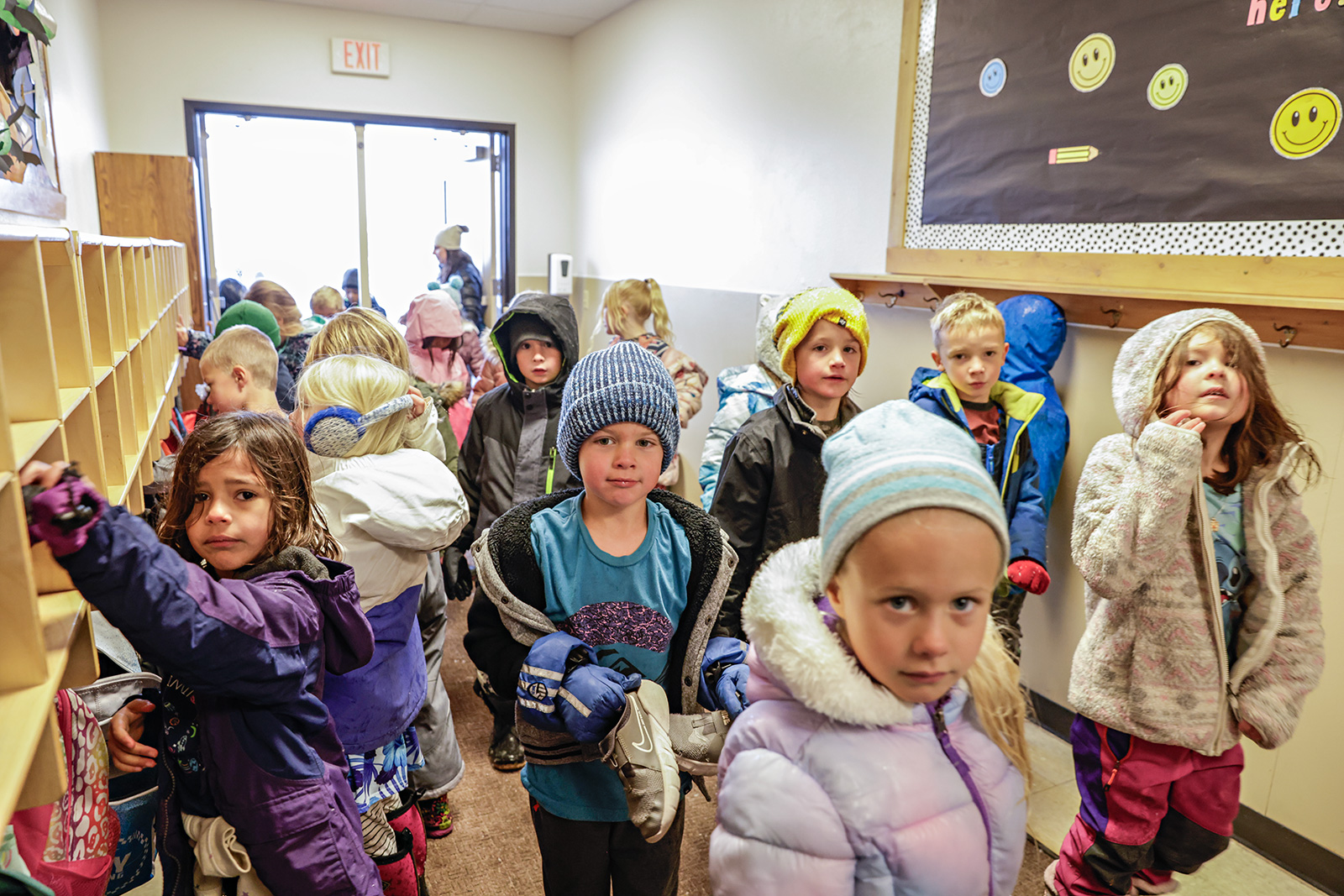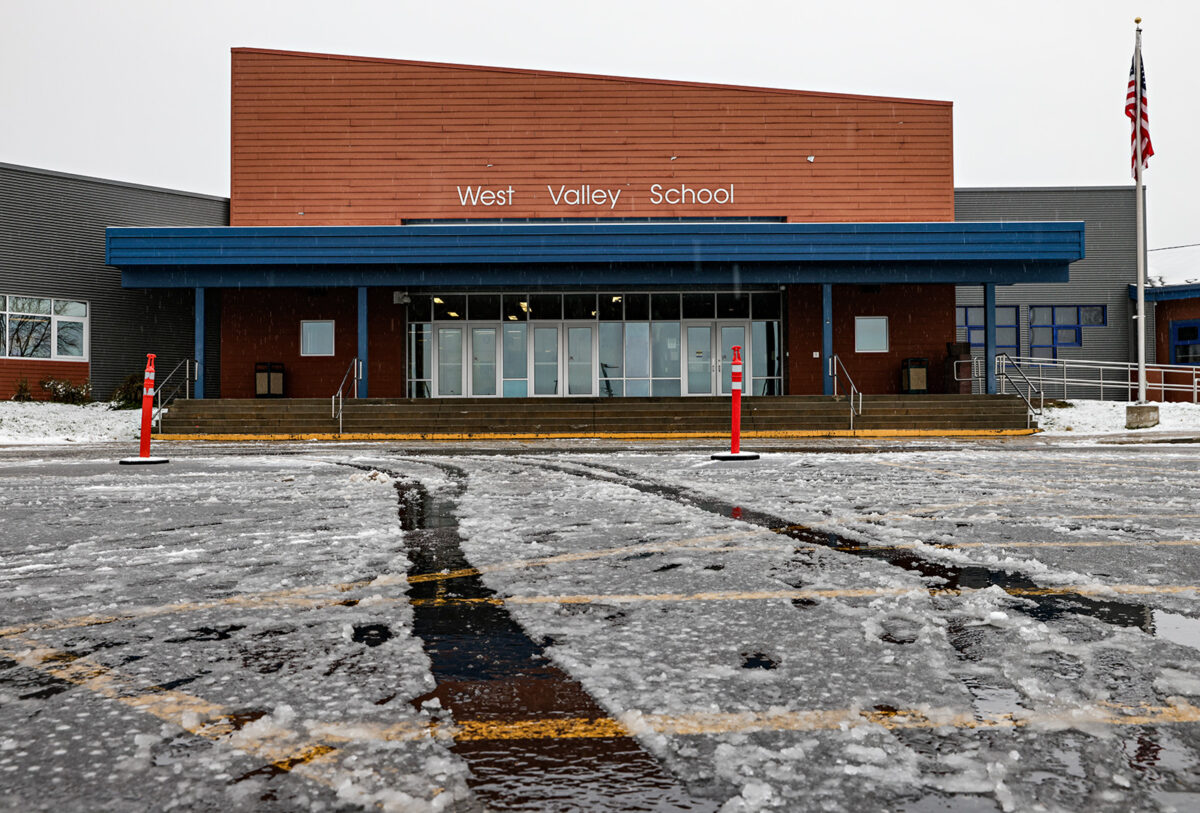As Kalispell Pushes Outward, West Valley School Feels the Effects
Hundreds of housing units are cropping up in the once-empty area northwest of Kalispell. With limited resources at its disposal, one small, rural school district is left to accommodate the wave of new children moving to the area.
By Denali Sagner
On a slushy November morning at West Valley School, hallway after hallway is a blur of multicolored snowpants, mittens and boots as the school’s elementary students trudge in from outdoor recess, noses red and hair tucked under knit hats. As West Valley Interim Superintendent Richard Gross maneuvers through the hallway, he nudges muddy boots to the side and addresses students, including his own first-grade son, who offer waves and greetings as they wiggle out of their snow attire. It’s cheery chaos, even on an overcast day, and even as teachers and students alike find themselves barely able to move through the overcrowded hallways.
In the school’s first grade wing, Gross points out an old conference room that the district converted into a classroom to accommodate additional students. Though it mostly functions, there’s only one small window, a feature that is acceptable for an occasional staff meeting, but not ideal for a full-time classroom.
“We used to be a small, farm school that was out in the country, but it seems like it’s doubling on itself every decade,” Gross said.
As the residential areas around Kalispell continue to grow, the West Valley School District has been pushed to its limits as teachers and administrators attempt to educate the largest number of students the district has ever seen. While the pressures of population growth have reached across Flathead County — increasing the demands on the area’s urban and rural schools — challenges in West Valley have been particularly acute. The district sits at the forefront of residential development occurring on the outskirts of Kalispell, while simultaneously attracting low-income families that have been priced out of their homes in the valley’s more expensive cities. With more students than ever before, educators in the elementary and middle school district are navigating new challenges and classrooms that are “bursting at the seams.”
Though growth has spread throughout the Flathead Valley, some of its most visible manifestations can be observed on the outer edges of Kalispell, where new subdivisions dot the once-open spaces to the north and west of town.
At least a half-dozen new housing developments — including West View Estates, Mountain Vista Estates, Spring Creek Estates, Meadows Edge, Bloomstone Homes and the Starling Community — sit within the bounds of the West Valley School District, even though some of the properties have been annexed by the city of Kalispell for utility purposes.
When it was approved in 2007, the Starling Homes subdivision project set out to deliver 3,000 new homes to the Kalispell area over the course of 20 to 30 years. Upon its approval in 2008, the Bloomstone Homes project planned to bring 569 units of housing. More recently, the Meadows Edge subdivision laid plans for 322 housing units, and Mountain View Estates set out to construct 407. Though many of the housing developments remain works in progress — and some ambitious goals set by developers have been stymied due to the 2008 recession, pandemic and ongoing labor and supply chain challenges — the area remains one of the fastest growing in the Flathead Valley.
And while many of the developments have been annexed by the city of Kalispell at the request of developers, school district boundary lines have remained the same.
“You can practically see Kalispell Middle School from their houses. It’s right down the road there. But they have to backtrack 6 miles to go to West Valley School,” Erica Wirtala, public affairs director for the Northwest Montana Association of REALTORS, said of the new housing developments popping up to Kalispell’s northwest.
“There have been a tremendous amount of homes going up,” she said. “That’s part of the constraint of the West Valley area, is that so much of it has been lost to these really big developments.”

With the explosion of housing developments in Kalispell’s northwest corner, the West Valley School District has seen an unprecedented increase in student enrollment. Over the past decade, West Valley reported a 40% enrollment increase, or 217 additional students.
In 1987, there were less than 200 students enrolled at West Valley School. In 2013, the school was home to 546 students. By 2022, that number had grown to 763.
The district has been forced to turn conference rooms and auxiliary spaces into classrooms to account for the growing student body. The gym is now split in half to serve double the number of students. Middle school students no longer have library periods during the day to accommodate the school’s growing elementary population. While the district aims to have one staff member for every 50 students in the lunchroom, the ratio was stretched to one staff member for 156 students at one point this year.
Gross called the growth “unsustainable.”
Out of 235 independent elementary school districts in Montana, Gross said, West Valley is now the second biggest.
“It’s definitely a lot more kids than I ever used to see,” Anna Porter, the school’s elementary counselor, said.
While the new housing developments have strained the district’s resources, the calculus of placing developments within certain school districts is a complicated one, PJ Sorensen, senior planner for the city of Kalispell, said.
Though municipalities are allowed to consider the impacts a housing development may have on schools, Montana Code Annotated prohibits governing bodies from denying approval of a proposed subdivision based solely on its impacts on educational services.
Sorensen said that while many of the housing developments north of Kalispell have been annexed into the city for utility purposes, city and school district lines have little to do with one another. If school administrators wanted to redraw the lines of the Kalispell Public Schools to encompass the city’s new subdivisions, which are currently located within West Valley, an agreement would need to be made between the two districts, which is unlikely, given the Kalispell Public Schools’ own challenges.

Even if an agreement could be reached, changing district boundaries to slow growth in West Valley would not necessarily benefit the school, Gross said.
Gross called the school’s predicament a “Catch 22.” While his facilities and staff are overwhelmed by the student growth, each child that attends West Valley brings in additional funding that the school needs, and each new home brings in tax dollars. The district receives $6,123 from the state of Montana per kindergarten through sixth grade student and $7,840 per seventh and eighth grade student that attends West Valley School.
The interim superintendent said that despite the district’s current struggles, it could not necessarily stand to lose the additional funding from new construction and new families.
Additionally, while new housing has brought challenges to the area’s public schools, the Flathead Valley’s population growth has far outpaced much needed housing units, a phenomenon that has provoked an uptick in homelessness and displacement.
“People are going to be living here anyway. They need a place to be,” Sorensen said.

While much of the district’s population growth has come from new housing developments, another segment of West Valley School’s population is also growing: low-income students whose families have been priced out of town.
“The demographic has changed a lot in the district, and so kids are coming with different needs and different situations that make school life a little bit more complicated,” Porter, West Valley’s elementary school counselor, said.
West Valley’s rural character has made it a magnet for families living in transition that may be unable to afford the Flathead Valley’s more expensive enclaves.
“It is cheaper to live in the county,” Wirtala, of the Northwest Montana Association of REALTORS, said, noting that families living outside of city lines do not have to pay additional taxes and city utility fees like residents of Kalispell, Whitefish or Columbia Falls.
Rural parts of Flathead County like West Valley are also popular areas for transitional housing setups like campers and RVs.
Crystal Thurman, the district’s middle school counselor, said she has seen more students living “in the wooded area of our district” or “living in a camper because they don’t have anywhere else to go.” The counselor also reported an uptick of families living with grandparents, friends or other relatives.

Both Porter and Thurman reported higher caseloads of students experiencing housing and food insecurity, as well as students who are forced to move schools repeatedly as their parents chase housing leads across the county and state. Demand for food assistance programs, and even for access to hygiene products and running water at school, has grown.
Porter said that in addition to classroom activities she leads, she sees anywhere between 10 and 12 students per day who need help with social-emotional regulation, mental health problems and academic struggles.
The school counselor said she’s found herself “being pulled in different directions” and “needing to do a little bit more in different areas to help out because we have so many kids.”
Both school counselors said the increase in students living in transition has made it more difficult to address social-emotional and academic needs.
“There’s a lot of kids who are going from district to district, and they’ll be here for a year or part of the year, and then they’ll move on. It’s kind of tough to be able to build those relationships, and for those kids to ever really feel supported and to feel that consistency that you have,” Porter said. “By the time you get that relationship, they’re on to the next school.”
Despite growing class sizes and caseloads, wages have remained stagnant in the district, making it difficult to recruit and retain additional staff.
Gross said that limited funding for public education has made it difficult for the district to hire teachers, a phenomenon that has impacted schools across the Flathead Valley.
“The problem is we’re just strapped for money,” Gross said. “Our starting pay is so low.”
In the 2021-22 school year, Montana ranked 51st in the nation for average starting teacher salary at $33,568 (a list that includes the District of Columbia). For average teacher salary, the state ranked slightly higher at 44th, or $53,628 annually. At West Valley, the starting wage for paraprofessionals is $12.88 per hour.
Though the Legislature has made some strides towards raising teacher pay, challenges remain in bringing salaries up to a livable wage, especially in the high-cost Flathead Valley.

Gross said that donations from the community and the passion of the school’s teachers have helped to keep the district afloat. West Valley’s band teacher purchased shelving units for her students out of her own pocket when the district couldn’t cover them. Donations often come from other schools and community centers that no longer need athletic equipment. Families who have more cash to spare make donations to funds designed to help low-income students.
It’s a patchwork system, Gross described, but it works for now. West Valley students are learning. In the 2021-22 school year, the district scored above state averages in math, reading and science proficiency, and scored above the state average for student attendance. Gross said that he’s proud of district’s outcomes, despite its many challenges.
Yet as the Flathead Valley continues to expand, and housing developments continue to crop up north of Kalispell, growth may become unsustainable for the West Valley School District.
The district has been unable to pass a levy since 2007. While the West Valley community supported a bond to expand the middle school in 2015, Gross said that “every inch” of the 35,000 square foot addition is now being used. A second bond put forth to account for growth in 2022 failed.
Gross said that the district will either see a plateau in its student population, or continued growth, but that enrollment numbers are not set to drop anytime soon. With construction continuing each day, the future is hard to predict.
“There’s just a lot of building, and this area is one of the last places to build in the valley right now,” Gross said.